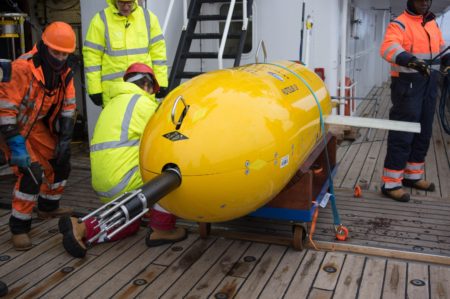June 19, 2019 – When the British allowed the public to name its polar research vessel a few years ago, the name that got the most votes was the RSS Boaty McBoatface. But after a year it has been rechristened the RRS Sir David Attenborough, named after one of Great Britain’s greatest naturalists and environmentalists. The submersible carried on board, however, has retained the Boaty McBoatface moniker. Known as Boaty for short, in its maiden voyage beneath the surface, it has discovered a link between Antarctic wind activity above the Southern Ocean and higher ocean temperatures.
What is the mechanism being observed?
With the increase in greenhouse gases from human activity as well as the thinning of the ozone layer over Antarctica, winds over the Southern Ocean are increasing in strength. As they travel across the ocean surface they cause turbulence leading to mixing that penetrates to the mid-depths of the water column. Warmer surface water penetrates deeper into the ocean’s mid-depths and mixes with the colder dense water found near the sea floor. This means the entire water column is warming and that leads to thermal expansion which has only one way to go, and that is up. Hence sea level rise.
A little bit of information about Boaty.
It is an autonomous underwater vehicle that is 3.62 meters (11.8 feet) in length, weighs 700 kilograms (over 1,500 pounds), can dive to 6,000 meters, (almost 19,700 feet) and has a mission range of 2,000 kilometers (approximately 1,200 miles). The mission it undertook is part of a joint project with the University of Southampton, Woods Hole Oceanographic Institute, British National Oceanography Centre, British Antarctic Survey, and Princeton University.
What is the implication of the discovery?
What Boaty is telling us is that climate models looking at ocean impacts need revision.
States Dr. Elenor Frajka-Williams, from the National Oceanography Centre in a news release this week, “The data from Boaty McBoatface gave us a completely new way of looking at the deep ocean—the path taken by Boaty created a spatial view of the turbulence near the seafloor.”
Professor Alberto Naveira Garabato, University of Southampton’s project leader, is quoted stating “Our study is an important step in understanding how the climate change happening in the remote and inhospitable Antarctic waters will impact the warming of the oceans as a whole and future sea level rise.”
The results of the mission are described in the June 17, 2019 issue of the journal, Proceedings of the National Academy of Sciences (PNAS). In the article entitled, “Rapid mixing and exchange of deep-ocean waters in an abyssal boundary current,“ it describes this previously undocumented mixing mechanism and the boundary currents that transfer heat from above into the deep ocean. These abyssal currents convey warmer surface water below ocean mid-depths. Boaty observed them as it descended into the ocean depths and cruised along for more than 180 kilometers (112 miles), a mere 90 meters (295 feet) above the ocean floor.
What are the numbers behind warming and sea level rise?
When you heat freshwater from room temperature to the boiling point it undergoes thermal expansion, increasing in volume by 4%. This is the same phenomena that occurs in a mercury thermometer when you have a fever and take your temperature. The heat from your mouth or other orifices causes the mercury in the tube to expand and rise.
Freshwater has a lower specific gravity than seawater. So thermal expansion in it increases even more than the 4% described above.
Then there is the consideration of how warmer water impacts surface ice and the continental ice shelves of Antarctica which lie partially over the Southern Ocean. In the past decade we have observed several large ice shelves in Antarctica fracture and break up because of warming ocean water undermining and eroding the ice shelves lying above.
Boaty’s first mission will prove to fill a critical knowledge gap in our understanding of the heating of the global ocean and will alter the modeling we currently use to forecast the impact of atmospheric warming and increased winds on the world’s oceans.















